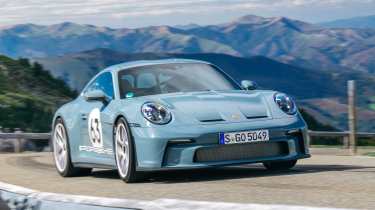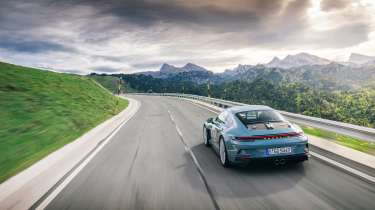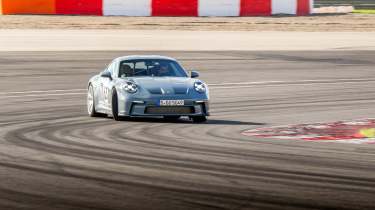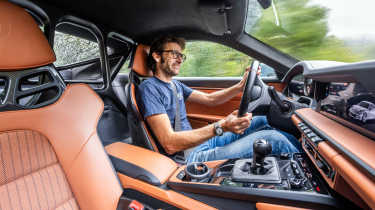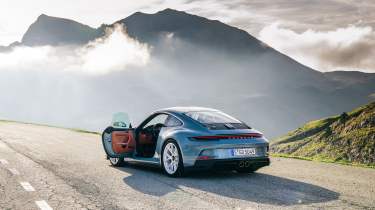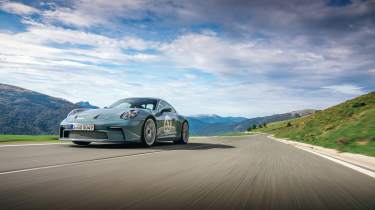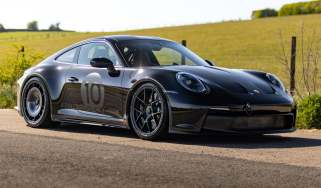Porsche 911 S/T review – why it's our 2024 Car of the Year
Designed to be the most engaging 911 for road use, the Porsche 911 S/T is thoroughly intense – and winner of eCoty 2024
A big birthday is a good excuse for a big birthday present, and the Porsche 911 S/T is the company’s 60th anniversary gift both to itself and to 911 fans. It’s a pricey present, however, and one that’s not for everyone: referencing the 911’s birth year (or the 901, pre-name change, if we’re being pedantic), 1963 cars will be built globally. In the UK it’s priced at £231,600 (before options).
Its name is taken from the classic Porsche 911 S/T, a competition package for the 911 sold from 1969 to 1972. In effect it combined the engine from the 911 S (the biggest of the time) with parts from the 911 T (the lightest 911 of the time), plus plexiglass windows and lightweight body panels. Various 911s with the S/T pack competed in circuit racing, rallies and hillclimbs. The 911 S/T was, in many ways, the forerunner of the now-mythologised 2.7-litre Carrera RS.
The new Porsche 911 S/T has a loosely similar philosophy in that it takes the relatively light, wingless 911 GT3 Touring as its base and adds the engine from the 911 GT3 RS but, uniquely, combines it with a manual gearbox.
It’s the lightest 992-generation 911 Porsche makes, weighing in at 1380kg wet, or circa 1270kg dry. It’s approximately 38kg lighter than a manual 911 GT3 Touring in its lightest possible specification.
More reviews
Unlike the original S/T, however, it is not intended to be a track car. It’s set up to be fun and engaging at road speeds and Porsche has no plans to record a Nürburgring lap time (although during development the car has recorded searingly quick times at test circuits, insiders say).
‘It’s a B-road blaster,’ Andreas Preuninger, Porsche’s director of GT cars, tells evo. ‘I don’t want to see the car on a track, because it doesn’t belong there. It’s not an RS, and it’s not a GT3 with a wing. Around the Nürburgring, I don’t have a clue how fast it is.’ As we found out on our 2024 Car of the Year test, the S/T is indeed a riot on the road – it came away with the overall win.
Engine, gearbox and technical highlights
Like the regular 911 GT3, the S/T uses the standard 992 bodyshell (the 911 GT3 RS, and the 911 Sport Classic, use the slightly wider shell from the 911 Turbo) but the naturally-aspirated engine is the very same as that in the active-aero, track-focused GT3 RS. It has around 15bhp more than the regular GT3 engine, with altered cams and a different cylinder head design for a 518bhp total, retaining the same 9000rpm redline.
This is the first time the modern GT3 RS engine has been combined with a manual gearbox, and the six-speed transmission has been given shorter ratios than the 911 GT3, by around eight per cent across the board.
The biggest transmission change concerns the clutch, however. The lightweight clutch and single-mass flywheel is unique to the S/T, reducing rotating masses by 10.5kg (and since that’s rotating mass it’s a virtuous circle, quite literally). The smaller clutch is around half the weight of a normal GT3 Touring’s, and inertia is said to be reduced by as much as two thirds. The differential has been tweaked too, with different lock settings on coast and power.
The aforementioned removal of rear-wheel-steering saves 7kg, and allows a smaller, lighter battery to be fitted too, since there’s less electric power demand from the rear-steer system. Aside from dietary reasons, it underlines the S/T’s mission of purity: no big wing, no PDK, no turbocharging, no all-wheel steering.
The dampers remain electronically controlled; in fact, the S/T uses exactly the same springs and dampers as the GT3 Touring, however the software has been comprehensively reworked. Porsche says a top chassis engineer spent 12 months retuning the PASM (Porsche Active Suspension Management) software for the S/T. If so, that shows how much freedom (and budget) Porsche and its GT division enjoys, as well as how much dedication has been lavished on this car.
As per the 911 GT3, it’s a double-wishbone set-up at the front (with the aerodynamic wishbones from the RS) and multi-link arrangement at the rear. The S/T doesn’t use the same centrally mounted radiator as the RS, however, so it has a full-size front luggage compartment.
Performance and 0-62mph time
Top speed is 186mph rather than the 198mph of the GT3 Touring, primarily due to the shorter gear ratios. The S/T isn't a car that's about top speed, and the absence of both stability-enhancing rear-wheel steering and a large fixed rear wing supports that approach (although there is a new gurney flap across the 911’s rump, attached to the active pop-up spoiler surface as per the GT3 Touring, which pops up at 75mph, or manually via a button on the dash).
Going all the way to 9000rpm actually demands a bit of willpower as well as space, such is the massive reach of the engine at the top end. The shorter gearing lends the S/T an even greater sense of urgency than a GT3, but it still has long legs and you find yourself using the upper mid-range most of the time. That mid-range feels mighty, in fact: above 3000rpm is where it starts to pull hard, then it gets a third wind around 6000rpm at which point it’s a thoroughly intense experience. It’s made all the more vivid by the lightweight clutch and flywheel, because as we’ll discuss later, the lack of inertia in the drivetrain means that quick, deliberate shifts work best.
Ride and handling
Getting underway, low-speed damping feels decidedly firm, in both standard and Sport modes (accessed via the same dashboard switch, or touchscreen menu, as the normal car) but remarkably well controlled. Even more so at higher speeds. We’ve tested the S/T on the remote, pothole-strewn Italian roads where it was signed off as well as on more familiar UK tarmac, and though it’s always a connected and full-blooded experience, there’s finesse and precision to the way it rides.
There’s not a stark distance between the standard and slightly stiffer Sport damper modes (‘In fact, we should probably have given ‘Sport’ a different name in this car,’ Preuninger ruminates); this isn’t a car where you press the button and feel an exaggerated change for the sake of it and Preuninger says that on bumpy roads, traction can actually be improved by selecting Sport, because the stronger rebound can keep the rear tyres in better contact with the tarmac.
An instant standout impression, more so than the suspension, is the steering, however. It’s been retuned with a different ratio, in deference to the absence of rear-wheel steering, and it’s remarkably direct. Even in hairpins, you don’t necessarily need to move your hands from quarter-to-three. Despite its responsiveness, you can place the car with natural sweeps of the wheel and it never feels nervous, delivering a stream of reassuring feedback to your hands without being knocked around by road scars or cambers. Preuninger says the benchmark for the S/T’s steering feel and response was the 997-generation 911 GT3 RS 4.0.
The whole thing is compounded by a sensation of enormous front grip and positivity when the Michelin Cup 2s dig in through a corner. Traction is immense too, torque only overcoming grip when the engine hits its stride higher in the rev band, at which point the S/T breaks away in a progressive, easily managed slide. Both ends of the car feel locked in unison and the communication through the chassis means that you apply corrective lock before your brain even thinks about doing so. It’s instinctive and massively rewarding.
The S/T is fitted with Porsche Carbon Composite Brakes (PCCB) as standard, with good feedback right from the top of the pedal – not always the case for ceramics. They contribute to the overall weight-saving, along with thinner glass and carbonfibre-reinforced plastic (CFRP) used for the roofskin, doors (same doors as the GT3 RS, with the built-in aero channels), front wings (bespoke to the 911 S/T, without the vents of the RS), and rear anti-roll bar, among other components. The optional half rollcage is made from CFRP, too. The S/T rides on magnesium centre-lock wheels (20 inches at the front, 21 at the rear; the only other 911 that can be specced with them is the GT3 RS with the optional Weissach Pack) which also contribute to the fine suspension control at speed.
The effect of that lightweight flywheel defines how you drive the S/T. Revs not only flick up swiftly when you tread the floor-hinged throttle pedal, but drop immediately when you lift too. It’s almost like a switch. As a result, you need to concentrate hard on your timing when changing gear; it’s easy to let the revs drop to idle before lifting the clutch for upshifts, resulting in a slightly jerky gearchange – or likewise on downshifts. The engine’s crisp response means it’s easy to send the revs upward with the edge of your right foot while you shift down a gear, but if you don’t move the lever quickly enough the revs will have dropped again by the time the clutch pedal comes up.
It demands practice and concentration but the satisfaction of a perfect shift is immense – and the excellent automatic throttle-blipping rev match software is on standby at a press of the touchscreen to take care of things if you fancy a break. The shift itself is short and meaty with a springy action across the gate, and though it is wonderful to use, it’s missing some of the metallic precision of Porsche’s very best manual gearboxes (specifically, the one you’ll find in the original Cayman GT4).
The transmission sounds thoroughly raw; at idle, there’s a pronounced clutch rattle, much like an older 911. Like a few all-time-great old Porsches, the engine and drivetrain sounds like a gently shaken cutlery drawer at low revs before clearing into a spine-tingling rasping shriek at higher revs. It’s reminiscent of the Mezger engine of the original 996 GT3.
Downsides? It can feel big on the road (it dwarfs a 996-generation 911, for example) – but that’s the case with all 992-era cars. Like all 911 GT3s, there are no rear seats, so you can’t take your family with you. And the always-on intensity might be too much for some. But it will make the 911 S/T irresistible to others. Then there’s the £230k price, and the limited availability – both making the car’s specification possible, and making the chances of owning one vanishingly small.
Interior and tech
The best way to describe the S/T’s cabin is that it feels like a modern 911 with a sprinkling of Singer-style magic lavished on the details. The architecture (carbon roll cage aside) and PCM infotainment system are the same as in a base Carrera, but the environment somehow feels infinitely more special and worthy of the huge price premium. The carbon bucket seats are mounted low and trimmed with retro fabric centres, there’s gold badging and almost every surface is covered in leather – including the door pulls, centre console, the edges of the floor mats and even the air conditioning vents.
The steering wheel is a simple leather item with a 12 o’clock stripe, and does without the GT3 RS’s suite of knobs and buttons for damper settings, DRS and adjustable traction control. Behind this you’ll find the 992’s usual analogue rev counter, but with green backlighting to reference 911s of old. Oh, and a 9000rpm redline.
The driving position is pretty much perfect. The wheel reaches out of the dash to meet you, the pedal box makes heel-and-toe shifts natural and the stubby manual gear lever is just a hand-span away from the wheel rim. There are no distractions and very few modes to fiddle with, focusing your mind on what the S/T is all about – the driving experience.
Design
The S/T looks very much like a GT3 Touring at first glance, but just like the cabin, there are enough bespoke details to make it somehow even more desirable. Specify the Heritage Design Package (costing a hefty £14,238) and you get exclusive paint colours, Porsche graphics along the flanks and classic-style Porsche badging, as well as silver mesh grills and gold badging. The S/T is less racy than a GT3 but somehow just as purposeful, thanks in part to carbon body panels shared with the GT3 RS.
As in the RS, the front wings and doors have been scalloped away to draw air out of the wheelarches, and the S/T also gets the RS’s signature double-bubble roof skin. The centre-lock magnesium wheels measure 20 inches at the front and 21 at the rear and fit snugly in the arches, and the rear end is a wing-free zone, with just a gurney flap and an active spoiler that deploys above 75mph.
It’s not an out-and-out crowd pleaser like a Huracán Tecnica, but the S/T’s presence and charisma is undeniable.
evo Car of the Year 2024 verdict
By the slimmest of margins, the 911 S/T won evo Car of the Year 2024. With its manual gearbox, inertia-free flat-six and shorter gearing, the limited-edition 911 is in some ways more focused than even the 911 GT3 RS that won last year. And what a flat-six it is, somehow more vibrant and visceral being hooked up to a six-speed manual, and more thrilling at 9000rpm when you know you’ve got to nail the next shift. That demand of the driver extends to the chassis, which, without rear-steer (one of the spec choices that helps make this the lightest 992 of all) means you have to be more positive, more deliberate, more involved, to make the most of the sporty Michelin Cup 2s.
No question, it’s a car that demands more of its driver, but by the same token it offers greater satisfaction. Two of our judges found it utterly compelling and placed it first. As deputy editor James Taylor said, ‘It was simply the car I enjoyed driving the most. There’s something totally immersive about the drivetrain, the chassis and the way it communicates everything to you – though not so much in the wet on those tyres. The flywheel and clutch frustrate as much as they reward – changing gear smoothly is a real challenge, on upshifts as well as downshifts – but when you get it right it’s a real thrill and hugely satisfying. I do think I’d have had as much fun in a GT3 or GT3 Touring, though.’
Henry Catchpole placed the S/T third and said that it never wowed him quite like the RS did last year, which he found strange and surprising. ‘I adore the engine, obviously – it’s the best in this group by a clear margin and a big part of why the car is so high up my list. You can’t help but smile when you get to rev it out and hear its motorsport-mimicking red line.
‘The shorter gearing is a boon to that extent too. However, the response of the throttle pedal seemed curiously lacking at the top of the travel, to the extent that I found I wanted to turn on the auto-blip feature. And I don’t want to turn on the auto-blip feature in an S/T where a big part of the joy is having three pedals. The chassis felt pretty edgy, too. Precise and poised but, for me, not as encouraging as the McLaren and Mazda.’
John Barker also had reservations. 'I’m up for a challenge and generally relish the chance to finesse a gearshift, but I could never relax into a drive in the S/T with its on/off engine revs and in/out clutch action. It was like taking a full-on race car on the road. It is a fabulous engine and I enjoyed the clarity of the dynamics but it was a liability on wet roads when, unexpectedly, the racier GT3 RS wasn’t last year. Ultimately I had more fun and more satisfying drives in other cars.'
Editor-in-Chief Stuart Gallagher wondered, slightly cynically, whether the S/T was an attempt to find the absolute sweet spot – the Goldilocks 911 – at the keenest end of the 992 range or just another concoction aimed at speculators. After his first drive, though, he was smitten. ‘Feels old-school with the gearbox chatter and lightweight clutch but, oh boy, on the right road it’s a proper thrill.’
‘The S/T is a car of contradictions,’ reckoned Dickie Meaden, who also made it his winner. ‘Narrower dynamic bandwidth than the 992 GT3 RS and trickier to drive – that clutch needs sympathy – but it offers such focus and purity. The powertrain is sensational, as is the way you connect with the whole car on a great piece of road – or racetrack. Makes me tingle just thinking about it. Not the runaway winner cynics would have predicted, which points to the S/T’s singular characteristics. Still, it’s hard to point to a car that embodies evo’s Thrill of Driving ethos more faithfully.’
Price and rivals
The £231,600 price and limited availability make the chances of owning an S/T vanishingly small, and prospective buyers will probably have to make a solid pitch to their local dealer to get their hands on one. Porsche hasn’t confirmed how many cars will be sold in the UK in right-hand-drive form out of the 1963 total production run, but limited-edition Porsches in the past have had close to 10 per cent of their total run allocated to the UK.
It's hard to think of anything that comes close to the S/T’s blend of usability, tactility, poise and sheer levels of desirability. It’s neither the fastest or most flamboyant sports car you can buy for the price, but it’s absolutely one of the most rewarding.
From Lamborghini, the Huracán Tecnica delivers an unforgettable driving experience and an even bigger dopamine hit than the S/T, but is more extreme, less usable and doesn’t quite have the same depth of dynamic quality. Ferrari will sell you a 296 GTB for similar money, which offers astonishing performance and technical ability in place of the Porsche’s unfiltered, analogue driving experience.
If the latter is what you’re after, then your best bet is a manual GT3 Touring. It won’t quite give you the same surreal adrenaline rush as the ST but it’ll certainly be more obtainable, and there’s scope to dial in even more intensity with a few Manthey upgrades.
Porsche 911 S/T specs
| Engine | Flat-six, 3996cc |
| Power | 518bhp @ 8500rpm |
| Torque | 343lb ft @ 6300rpm |
| Weight | 1380kg (381bhp/ton) |
| 0-62mph | 3.7sec |
| Top speed | 186mph |
| Basic price | £231,600 |
